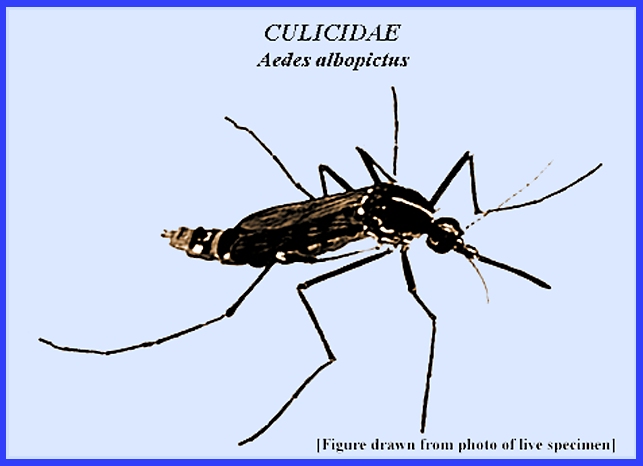File:† <zika.htm>††††††††††††††††††††††††††††††††††††††† ††††††††††††††† ††††††††††††††††††††††††††††††††††††††††††††††† <General Index>†††††† Site Description††
††Glossary††† <Navigate
to Home>††††
|
ZIKA VIRUS DISEASE (Contact) † Please CLICK on
Image & underlined links for details: † †††††† The virus
originated in central Africa and had spread quickly to the South Pacific and
Western Hemisphere.† It is related to West Nile, Yellow Fever, St Louis and the equine encephalitides.† As of January 2017, there have been more
than 432 reported cases of Zika
virus due to human travel to endemic areas. However, local transmission
within the continental United States has already begun. In US Territories of
the Caribbean, a total of 612 cases have been reported, with 601 being
locally acquired, primarily in Puerto Rico (one-third of the population is
infected) and the US Virgin Islands. †††††† The virus is
spread to humans primarily through the bite of an infected Aedes aegypti or Aedes albopictus
mosquito; but pregnant women can pass it to
the fetus during pregnancy or near the time of birth.† Many who have been infected with Zika show only mild symptoms that endure
for about a week.† There may be some
effects on the nervous system of an infected person also.† Once infected it is expected that future
infections might not occur.† As of
2016 there is no evidence that a previous Zika
virus infection poses an increased risk of birth defects in future
pregnancies. †††††† The mosquito
vectors of Zika virus lay their
eggs above the waterline in containers, treeholes, creases in tarpaulins and
other vessels that hold water. Aedes aegypti, in particular, will lay
eggs in a series of containers after feeding. Both Aedes aegypti,and Aedes albopictus feed day or
night when a potential host comes within their limited flight ranges. Aedes agypti is found quite often within
houses if conditions are proper. This species is wary often leaving its host
before taking a full blood meal when the host moves. Both mosquitoes also
seem to prefer feeding on the hostís lower extremities †††††† Prevention is
to wear long-sleeved shirts and long pants.†
Sleep with a mosquito net, especially outdoors, or in a screened
dwelling.† Air conditioning will also
serve some protection from the vector mosquitoes.† The application of repellents is
also useful. Outdoor sprays are not very effective against Aedes aegypti,,
because it is hard to contact them with the sprays.† Some success with ultra low volume sprays has been obtained
against Aedes albopictus in urban
areas, while suburban areas remain refractory. The primary means of
controlling both species is to eliminate their oviposition habitats by removing
containers where they breed or emptying them and removing eggs laid above the
waterline. and wearing of Zika Virus - 2016 World Distribution † = = = = = = = = = = = =
= = = = = = = = Key References:†††† <medvet.ref.htm>††† <Hexapoda> †††† Matheson, R. 1950.†
Medical Entomology.† Comstock
Publ. Co, Inc.† 610 p. ††††† Service, M.† 2008.† Medical
Entomology For Students.† Cambridge
Univ. Press.† 289 p ††††† Legner,
E. F.† 1995.† Biological control of Diptera of medical
and veterinary importance.† J. Vector
Ecology 20(1): 59_120. ††††† Legner,
E. F..† 2000.† Biological control of aquatic
Diptera.† p. 847_870.† Contributions to a Manual of Palaearctic
Diptera, ††††††††† Vol. 1, Science† Herald, Budapest.† 978 p. |
